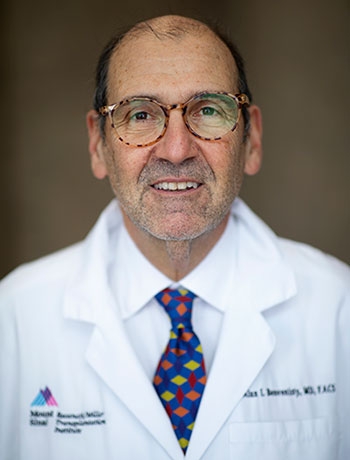At Union, I studied complex neuroanatomy, firmly entrenching myself as a budding neurologist. I was sure this was my calling.
Then I completed my first clinical rotation at Columbia P&S in neurology. I hated it! Back in 1976, neurologists were able to cure very little. I needed to make people better and I needed to see it happen in front of my eyes.
That is what is so wonderful about being an academic vascular and transplant surgeon. Nothing is more satisfying than enabling a patient with kidney failure to be a productive member of society again. Or fixing the carotid artery of a patient so he/she will not become a stroke victim.
I have had the good fortune of doing this for 42 years. And I’ve seen a lot during this time. I watched the AIDS epidemic unfold before we knew a virus caused it. I performed innumerable lymph node biopsies on cachectic young men with fevers and weight loss. I watched the World Trade Towers crumble down from the operating room windows in Washington Heights. I watched, as we got ready for Ebola victims and worried about West Nile and Zika.
Nothing could possibly match the dramatic metamorphosis of our health care system that we have witnessed fighting COVID.
I entered this fight March 14, 2020. That was the date a patient I saw just days before—seemingly well—was admitted with COVID and placed on a ventilator. He died a few days later in multi-organ system failure.
We were in the process then of shutting down all normal activities and ramping up for “the surge.” On that day, my job as a vascular and transplant surgeon came to a grinding halt.
All elective cases stopped and we performed surgeries only for life- or limb-threatening emergencies. Everyone in my great Department of Surgery at Mount Sinai became a soldier in the army, each assigned to a different position.
As a senior vascular surgeon, I became captain of the “line team.” With a platoon of amazing surgical residents, we patrolled the ICUs at Mount Sinai West. We placed small tubes and straw-sized catheters in arteries and veins of critically ill patients to administer medications and treatments. Most of these individuals were on ventilators.
Because many of the COVID victims developed renal failure, we provided vascular dialysis access for that as well.
I also provided emergency vascular surgery coverage for two hospitals, putting out the usual fires that we take care of in my specialty. For a brief time, I covered a COVID discharge unit where we developed discharge plans for patients who were lucky enough to recover and go home. That was a sweet and rewarding job!
Although it was a harrowing experience, I have been awestruck by several things.
First, the Mount Sinai system went to the ends of the Earth to do what they could to protect their health care workers and transform the hospital into one massive critical care machine.
We had the protective armor we needed, when we needed it. It was very scary when it looked like the personal protective equipment would be insufficient. As a person in the high-risk category (over age 60), the unknown danger was particularly worrisome, especially since two of my classmates from Columbia P & S had already succumbed to COVID.
Second, my view of other health care professionals is forever changed.
I see the housekeeping staff, who painstakingly clean the ICUs and patient care areas, as real fighters. They are risking their lives. They did not sign up for that. The nurses, physician assistants and respiratory therapists—what guts they have. Talk about front line! The anesthesiologists are amazing heroes, staring right in the face of the virus intubating highly contagious patients.
Kudos to all of my colleagues who are so brave.
The saddest part was the cruel loneliness that patients and their families endured when they could not accompany each other in their time of greatest need. I spoke to a wonderful hospital worker who lost her elderly mother and cried to me that she had to bury her and sit Shiva alone.
The most tragic part of the whole affair was the fact that we in New York got through this hellish situation but other parts of the country did not learn enough from our struggle. There are still many people in the hospitals to fight for and unfortunately, COVID admissions keep coming in. Now that the surge in New York is over (and hopefully for good), I am happy to be a vascular and transplant surgeon again. I hope that my colleagues in other states soon enjoy the same privilege. I am praying that as we progress forward, I will only be seeing the fading image of COVID in my rear view mirror.

